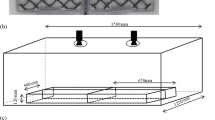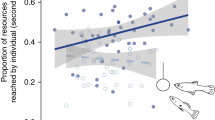Abstract
The benefits and costs of group living are likely to be asymmetric within a group. Animals at the edge of a group are more at risk from predators, according to the selfish herd hypothesis, but are also more likely to obtain scattered food resources. Does an animal's choice between these two conflicting positions depend on its body reserves? The hunger level of marked whirligig beetles (Coleoptera: Gyrinidae) was manipulated and the positions of individuals relative to the rest of the group on the surface of the water were determined with image analysis software. In 12 out of 13 groups, of approximately 18 beetles each, hungry beetles were closer to the edge of a group and had a higher distance to their nearest neighbor than well-fed beetles. Hungry beetles at the edge obtained nearly all of the food particles dropped onto the surface of the water. These results show that position preferences within groups may involve a dynamic feedback between foraging, predator avoidance, and shortterm hunger levels.
Similar content being viewed by others
References
Bendele H (1986) Mechanosensory cues control chasing behaviour of whirligig beetles (Coleoptera, Gyrinidae). J Comp Phyisol A 158:405–411
Benfield EF (1972) A defensive secretion of Dineutes discolor (Coleoptera: Gyrinidae). Ann Entomol Soc Am 65:1324–1327
Brown JL, Orians GH (1970) Spacing patterns in mobile animals. Annu Rev Ecol Syst 1:239–262
Brönmark C, Malmqvist B, Otto C (1984) Anti-predator adaptations in a neustonic insect (Velia caprai). Oecologia 61:189–191
Dill LM, Ydenberg RC (1987) The group size-flight distance relationship in water striders (Gerris remigis). Can J Zool 65:223–226
Eggers DM (1976) The theoretical effects of schooling by planktivorous fish predators on rate of prey consumption. J Fish Res Board Can 33:1964–1971
Foster WA, Treherne JE (1981) Evidence for the dilution effect in the selfish herd from fish predation on a marine insect. Nature 295:466–467
Freilich JF (1986) Contact behavior of the whirligig beetle Dineutes assimilis (Coleoptera: Gyrinidae). Entomol News 97:215–221
Gilliam JF, Fraser DF (1987) Habitat selection under predation hazard: test of a model with foraging minnows. Ecology 68:1856–1862
Godin J-GJ (1986) Risk of predation and foraging behaviour in shoaling banded killifish (Fundulus diaphanus). Can J Zool 64:1675–1678
Hamilton WD (1971) Geometry for the selfish herd. J Theor Biol 31:295–311
Healey MC, Prieston R (1973) The interrelationships among individuals in a fish school. Fish Res Board Canada Tech Rep 389
Heinrich B, Vogt D (1980) Aggregation and foraging behavior for whirligig beetles (Gyrinidae). Behav Ecol Sociobiol 7:179–186
Jennings T, Evans SM (1980) Influence of position in the flock and flock size on vigilance in the starling (Sturnus vulgaris). Anim Behav 28:634–645
Keys GC, Dugatkin LA (1990) Flock size and position effects on vigilance, aggression, and prey capture in the European starling. Condor 92:151–159
Krause J (1993) The relationship between foraging and shoal position in a mixed shoal of roach (Rutilus rutilus) and chub (Leuciscus cephalus): a field study. Oecologia 93:356–359
Krause J (1994) Differential fitness returns in relation to spatial position in groups. Biol Rev 69:187–206
Krause J, Bumann D, Todt D (1992) Relationship between the position preference and nutritional state of individuals in schools of juvenile roach (Rutilus rutilus). Behav Ecol Sociobiol 30:177–180
Krebs JR, Davies NB (1993) An introduction to behavioural ecology. Blackwell, Boston
McFarland WN, Moss SA (1967) Internal behavior in fish schools. Science 156:260–262
McNamara JM, Houston AI (1990a) State-dependent ideal free distributions. Evol Ecol 4:298–311
McNamara JM, Houston Al (1990b) The value of fat reserves and the tradeoff between starvation and predation. Acta Biotheor 38:37–61
Merritt RW (1978) An introduction to the aquatic insects of North America. Kendall/Hunt, Dubuque, Iowa
Milinski M (1977) Do all members of a swarm suffer the same predation? Z Tierpsychol 45:373–388
Milinski M, Heller R (1978) Influence of a predator on the optimal foraging behaviour of sticklebacks (Gasterosteus aculeatus L.). Nature 275:642–644
Milinski M, Parker GA (1991) Competition for resources. In: Krebs JR, Davies NB (eds) Behavioural ecology, an evolutionary approach, 3rd edition. Blackwell, Boston, pp 137–168
Nuernberger BD (1991) Population structure of Dineutes assimilis in a patchy environment: dispersal, gene flow, and persistence. PhD Thesis, Cornell University, Ithaca, New York
Parish JK (1989) Re-examining the selfish herd: are central fish safer? Anim Behav 38:1048–1053
Petit DR, Bildstein KL (1987) Effect of group size and location within the group on the foraging behavior of white ibises. Condor 89:602–609
Pitcher TJ, Parish JK (1993) Functions of shoaling behaviour in teleosts. In: Pitcher TJ (ed) Behaviour of teleost fishes. Chapman and Hall, New York, pp 363–440
Pitcher TJ, Wyche CJ, Magurran AE (1982) Evidence for position preferences in schooling mackerel. Anim Behav 30: 932–934
Pulliam HR, Caraco T (1984) Living in groups: is there an optimal group size? In: Krebs JR, Davies NB (eds) Behavioural ecology, an evolutionary approach. Sinauer, Sunderland pp 122–147
Rayor LS, Uetz GW (1990) Trade-offs in foraging success and predation risk with spatial position in colonial spiders. Behav Ecol Sociobiol 27:77–85
Rayor LS, Uetz GW (1993) Ontogenetic shifts within the selfish herd: predation risk and foraging trade-offs change with age in colonial web-building spiders. Oecologia 95:1–8
Romey WL (1993) Grouping in whirligig beetles. PhD Thesis, State University of New York, Binghamton
Romey WL (1995) Why are some animals more likely to be on the outside of a school? testing evolutionary predictions. In: Parish JK, Hamner WM, Prewitt CT (eds) Three dimensional animal aggregations. Cambridge University Press NY (in press)
Sih A (1980) Optimal behavior: can foragers balance two conflicting demands? Science 210:1041–1042
Theodorakis CW (1989) Size segregation and the effects of oddity on predation risk in minnow schools. Anim Behav 38: 496–502
Thornhill R, Alcock J (1983) The evolution of insect mating systems. Harvard University Press, Cambridge
Vulinec K, Miller MC (1989) Aggregation and predator avoidance in whirligig beetles (Coleoptera: Gyrinidae). J NY Entomol Soc 97:438–447
Author information
Authors and Affiliations
Additional information
Communicated by M.A. Elgar
Rights and permissions
About this article
Cite this article
Romey, W.L. Position preferences within groups: do whirligigs select positions which balance feeding opportunities with predator avoidance?. Behav Ecol Sociobiol 37, 195–200 (1995). https://doi.org/10.1007/BF00176717
Received:
Accepted:
Issue Date:
DOI: https://doi.org/10.1007/BF00176717




